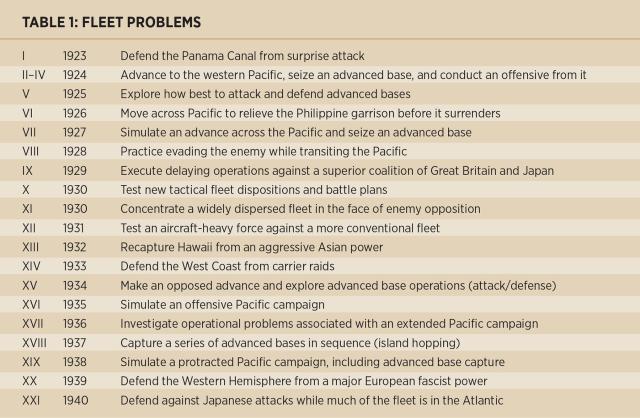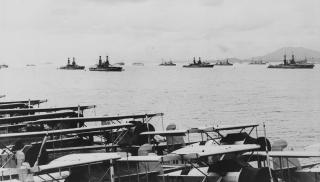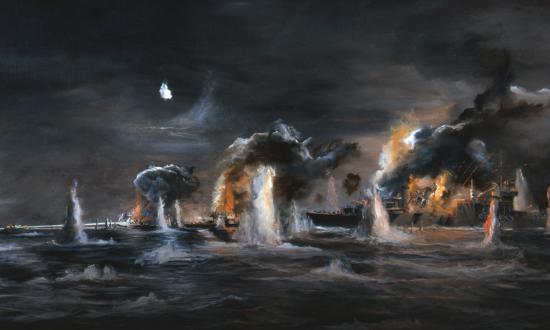The challenges confronting today’s Navy are substantial. Technology is changing rapidly, peer adversaries are developing new capabilities, and the best way forward is uncertain. Fortunately, history offers some valuable lessons for how to explore, experiment, and share knowledge to develop answers for some of today’s most difficult questions. One example begins more than a century ago and culminates in the U.S. Navy victory over the Imperial Japanese Navy (IJN) at Midway in June 1942.
In the late 1800s and early 1900s, the U.S. and Imperial Japanese navies approached strategic and technological unknowns in markedly different ways. The U.S. Navy’s choices better prepared it for the uncertainty of combat and the challenges of new technologies and enabled it to deliver devastating counterpunches in the first half of 1942, well before the U.S. industrial base had fully ramped up.1
Key factors that allowed the Navy to succeed were:
• Delegation of authority and responsibility to experiment at small scale and at low risk
• Mechanisms for knowledge capture and sharing
• Incremental decomposition of large problems into small, conceptually tractable steps
• A culture of forceful feedback so plans, designs, and ideas receive constructive critique before being finalized
• Regular cycles of planning, preparation, and performance so future plans are informed by past experience
These approaches are just as valuable today as they were a century ago.
Same Problem, Two Approaches
By the summer of 1942, the IJN should have been celebrating. In December 1941, it had unleashed an offensive of unprecedented size and scope, rapidly capturing Guam, Singapore, and the Philippines. There were setbacks—most notably the Battle of the Coral Sea in May 1942—but a decisive victory was expected in June. As the IJN’s Combined Fleet approached Midway, it outnumbered its U.S. opponents in every category that mattered.
But during the Battle of Midway, the Pacific Fleet surprised the IJN, sank four carriers of the Kido Butai, and turned the tide of the war in the Pacific.
How did the U.S. Navy triumph? There are many answers: Code-breaking was significant, as was the initiative of pilots such as Lieutenant Commander Wade McClusky, commander of the USS Enterprise (CV-6) air group. However, Jonathan Parshall and Anthony Tully, authors of Shattered Sword: The Untold Story of the Battle of Midway, contend the IJN’s fate was sealed more than a decade prior. After examining the battle from the IJN’s perspective, they conclude that crucial decisions during the fight were informed by beliefs and assumptions that had been ingrained long before.2
By 1929, the Japanese Navy had locked into a doctrine of massive and devastating first strike. It expected a hard first punch would wreck the opposing fleet and destroy the adversary’s will to fight. This was an extrapolation from the Russo-Japanese War and the logic behind the Pearl Harbor raid. This emphasis on “decisive battle” anchored the IJN’s plans. Confident in its conclusion, the IJN set to work designing tactics and force structure around the concept—building planes and ships that could secure an initial advantage by striking first at extreme range.3
Although the emphasis on decisive battle brought focus, it also created a dangerous certainty, which influenced the IJN’s decision-making. Parshall and Tully describe how in war games conducted before Midway the threat of a potentially more assertive Pacific Fleet that might fight differently than expected was brushed aside. In part, this can be attributed to the personal prestige Admiral Isoroku Yamamoto, Commander-in-Chief of the Combined Fleet, had invested in the Midway plan, but the emphasis on decisive battle also played a role. As a result, the IJN missed an opportunity to learn from the initiative of younger officers who were playing the role of the U.S. Navy, assess flaws in their assumptions, and improve their plans.
Generating a Learning Culture
The U.S. Navy’s approach contrasted markedly with that of the IJN. Starting in the 1890s, senior Navy officers emphasized experimentation and distributed decision-making. One reason for this was technology was undergoing a step change, marked by the introduction of the destroyer, the submarine, the dreadnought battleship, steam-turbine propulsion, and radio. Modern ships were faster, more lethal, and could fight at longer ranges; naval combat was transforming.
In such an environment, it would have been reasonable for the Navy hierarchy to determine an effective approach and then impose it on the fleet. There were calls for new tactical forms and rigorous experimentation to determine the best ones. The Navy’s “Battle Plan No. 1” was such a concept. This is a comfortable pattern: Assign the problem to a dedicated team of “experts,” have them determine solutions, and then have the fleet execute those solutions and measure compliance. Other navies of the day followed patterns like this.
The U.S. Navy did not. At the dawn of the 20th century, senior officers admitted—some explicitly and others implicitly—they had no answer. Instead of imposing solutions, the Navy emphasized learning. Experimentation was used to determine the potential of new technologies and how best to use them. By allowing different ships to explore alternative approaches, multiple avenues could be investigated simultaneously, and situational nuance could emerge. Local experimentation coupled with mechanisms for harnessing and sharing newly acquired knowledge allowed the Navy to rapidly develop new tactics and techniques.
Delegate for Iterative Experimentation
One of the initial challenges involved fire control. How could the new, higher velocity guns hit targets at much greater ranges? During the Spanish-American War, at the Battles of Manila Bay and Santiago, the U.S. Navy’s hit rates were around 1 percent. This poor performance stimulated efforts to improve. Initial gains were achieved when the new Inspector of Target Practice, Lieutenant Commander William S. Sims, introduced gunnery practices to train the fleet in continuous aim, a concept developed by the Royal Navy. This increased the speed with which gunners hit their targets by 100 percent and improved overall effectiveness by 500 percent.4
The real value of Sims’ work, however, was the introduction of a system of target practice that could be used to continuously refine the Navy’s methods. That system relied on standardized rules, competition, and—this is key—dissemination of lessons from failures and successes during practice to advance collective understanding. When it became apparent that individual gunners could not control the fire of their guns at anticipated battle ranges, the system of target practice spurred the development of centralized fire-control techniques, with spotters aloft adjusting the fire of coordinated salvos rather than individual guns.
Once experimentation solved one problem, new ones emerged. Getting the guns on target required new technologies, such as target bearing indicators, range projectors, and mechanical fire-control computers. The Navy used distributed experimentation and knowledge sharing recursively, addressing one problem after another and expanding beyond the challenge of fire control.5
During World War II, this same approach was used to integrate new technologies—such as radar and very high frequency radio—into tactical doctrine. Early in the war, ships regularly lost situational awareness as their officers were overwhelmed by the flood of information generated by these new technologies. The combat information center (CIC) addressed the issue by providing a way to collect, consolidate, and display relevant information. To rapidly develop CIC techniques, Admiral Chester W. Nimitz used experimentation. He told the ships of the Pacific Fleet the outcomes they should strive for but left them free to determine the best techniques, even to the extent of reconfiguring internal layouts to enhance their performance.
Capture Lessons and Improve Existing Approaches
Without the ability to harness lessons from distributed experimentation, the Navy would have had some great performers, many that were adequate, and a few poor ones. Instead, because lessons routinely were assessed and synthesized, the Navy improved as a whole. One mechanism for distributing lessons was the type commands. They were responsible for identifying, refining, and disseminating official doctrines and practices. Another was the fleet structure. Destroyer squadrons, cruiser divisions, and carrier air wings took the guidance from their type commands and balanced it against their own experiences and ingenuity to craft contextual approaches.
During the interwar period (1919–39), the Naval War College enhanced the Navy’s ability to learn by helping to structure the Fleet Problems, informing the rules that governed them, and familiarizing officers with a variety of important processes, such as how to craft and frame orders. It also analyzed hypothetical problems, those that could not be worked through in the fleet because of various constraints. The Naval War College, for example, could simulate a large Pacific campaign over months; the fleet could not.
Decompose Large Problems into Small Steps
Both the IJN and the U.S. Navy faced the challenge of projecting power across the vast distances of the Pacific, but they approached it differently. The IJN decided early to focus on decisive battle, which provided a foundation for how to train and equip the Combined Fleet. The U.S. Navy preserved its options longer. Its senior officers recognized that they did not know exactly how to create a transoceanic force and triumph in a war against Japan. That is why, starting in 1923 and continuing for nearly two decades, they ran a series of Fleet Problems to explore the challenge.
The Fleet Problems explored key questions, such as:
• If the Panama Canal is key for moving ships and supplies, how should it be defended from attack?
• How can we integrate aircraft carriers and their air wings with the fleet?
• What is the best way to seize and establish an advanced base?
• How can we defend the battle fleet against attack from submarines and light forces as it moves across the Pacific?
The fleet regularly took to sea to explore these questions, test ideas, and determine what worked and what did not.6 Lessons were integrated with an increasingly sophisticated understanding of the challenges of modern naval warfare, allowing the U.S. Navy to keep pace with advancing technology and reinforcing the need to test and validate assumptions. To contrast the different approaches of the two navies, consider that in 1929, when the IJN anchored to decisive battle, the U.S. Navy was focused on the operational challenges of a Pacific war, such as seizing advanced bases and conducting sustained offensive operations from them.
Introduce a Culture of Fast and Frequent Feedback
In effect, the Fleet Problems took the recursive incrementalism used to explore the problems of fire control and applied it at large scale.7 That learning model relied on feedback, and during the Fleet Problems it took place at the most senior levels of command. After each one, there was a large debrief with the commanding officers who had participated in the problem. The open sharing of experiences and perspectives made it more apparent what had worked, what had not, and where the Navy’s plans needed to be improved.
The performance of senior commanders was not immune to criticism. If they had mishandled their forces, made poor estimates, or issued unclear orders, those facts came out in the debrief. It was a feedback and learning opportunity for all. This honest assessment of existing limitations and capabilities was one reason Admiral Nimitz was driven to claim after the war, “Nothing that happened in the Pacific was strange or unexpected.” The prewar exploration had thoroughly prepared him and his peers for the conflict they eventually would fight.8
Cycle Among Planning, Preparation, and Performance
It would be understandable to conclude that the Navy’s learning system operated effectively during peacetime but was abandoned under the pressures of war because of the need to fight and win. But it would be wrong. The Navy continued to learn.
One of the reasons it was able to do so is that it built in the capacity to recuperate and reassess. One of the best examples is combat pilots. Navy pilots regularly cycled back to Hawaii and the United States so they could rest, share their experiences with others, and return to combat refreshed. When they came back to the operating theater, their skills were used to improve the training and preparation of others, constantly advancing tactics and doctrine.
IJN pilots, in contrast, were sent out without recuperative breaks. This was a bleak fate for pilots, but it was devastating to the IJN’s ability to learn and improve. By failing to systematically leverage the skill of combat pilots, doctrine and tactics failed to keep pace with actual experience. Accordingly, the ability of new IJN pilots degraded during the war, while the ability of U.S. Navy pilots increased.
The IJN’s decision not to cycle its aviators mirrored the situation in the European theater in 1940, when the British and Germans were fighting the Battle of Britain. The British, even though they were on the defensive, deliberately cycled their aviators for periods of rest and recuperation, acknowledging the need to recover from the physical and psychological stress of air-to-air combat. This allowed them to share lessons and systematically capitalize on the most recent combat experience. The Germans, in contrast, perhaps hoping to maintain the offensive and secure a decisive victory, emphasized the needs of the present over those of the future. Their crews flew more missions and logged more flight hours. They had fewer opportunities to recuperate and were less effective at sharing their experience with others. Basically, they began to burn out and did not have a chance to regenerate their capabilities.9
Application Today
In June 1942, Admiral Yamamoto was optimistic about the Combined Fleet’s chances at Midway. What he did not appreciate was that his foe possessed a “secret weapon”: the many lessons gathered from distributed experimentation across multiple scales and the behaviors and culture necessary to deploy those lessons at a much faster rate. That “secret weapon” would hand his fleet the greatest defeat in its history.
While today’s strategic and technological challenges are far different, there is much to learn from the Navy’s approach of a century ago. Now, as then, success depends on harnessing the creative potential of service members to achieve a common purpose. The Navy was effective at doing that in the years before World War II, and, if it embraces these five principles once more, it can do so again.
1. The late 19th and early 20th centuries were a period of “disruptive innovation” for naval warfare. New technologies, weapons, and platforms such as steam propulsion, radio, the torpedo, the submarine, and the airplane challenged established tactical and operational concepts. That meant that “sustaining innovation”—getting better at existing ways of doing things—was insufficient. New platforms created the opportunity to contest spaces that had not been contested before and fight in ways previously unanticipated. Navies had to determine how to employ new platforms and technologies to achieve their objectives.
Alternative concepts emerged, such as the French Navy’s Jeune École, Admiral John Fisher’s plans for the Royal Navy’s battle cruisers, and the IJN’s First Air Fleet or Kido Butai. As is typical with “disruptive innovations,” the platforms involved supported new technologies and were less effective at “traditional” roles but offered the potential for paradigmatic operational shifts. Battle cruisers were poorly suited to the line of battle but could police vital shipping lanes and destroy raiders. The Kido Butai lacked the sustained fighting power of a battle fleet but could overwhelm one with a long-range pulse of airpower. These disruptive innovations were rooted in sociological and organizational changes that repurposed existing technologies to support new tactics and operational concepts. They reshaped the contested space. As technology and operational doctrine co-evolved, what had been a “disruptive approach” to contesting a new space could become the dominant paradigm. This happened with aircraft carriers but not the Jeune École or battle cruisers. Organizations with the adaptability to explore these alternatives can gain a decisive advantage, provided they honestly assess their new concepts and use regular feedback to validate them.
For more details, see Clayton Christensen, The Innovator’s Dilemma (Boston: Harvard Business Review Press, 1997), Theodore Ropp, The Development of a Modern Navy: French Naval Policy, 1871–1904, ed. Stephen S. Roberts (Annapolis, MD: Naval Institute Press, 1987), Jon T. Sumida, In Defence of Naval Supremacy: Finance, Technology, and British Naval Policy, 1889–1914 (New York: Routledge, 1993), and Mark Peattie, Sunburst: The Rise of Japanese Naval Air Power, 1909–1941 (Annapolis, MD: Naval Institute Press, 2002).
2. Jonathan Parshall and Anthony Tully, Shattered Sword: The Untold Story of the Battle of Midway (Sterling, VA: Potomac Books, 2005).
3. David C. Evans and Mark R. Peattie, Kaigun: Strategy, Tactics, and Technology in the Imperial Japanese Navy, 1887–1941 (Annapolis, MD: Naval Institute Press, 1997).
4. LCDR Benjamin F. Armstrong, USN, “Continuous-Aim Fire: Learning How to Shoot,” Naval History 29, no. 2 (April 2015).
5. There is a parallel with modern “‘agile” approaches for developing software, rapid sprints to a succession of minimally viable products. Try to accomplish one thing, find out what needs modification, and quickly use the incremental feedback to find new problems and iterate through a succession of solutions.
6. Albert A. Nofi, To Train the Fleet for War: The U.S. Navy Fleet Problems, 1923–1940 (Newport, RI: U.S. Naval War College, 2010).
7. Note that this approach of decomposing a very large problem into a series of smaller, more tractable ones was how the Apollo lunar program succeeded. The “small step” Neil Armstrong took as he set foot on the moon was the result of many cycles of testing, validating, and learning.
8. The exception was, of course, the Japanese decision to employ kamikaze tactics.
9. The U.S. Navy was not immune to this challenge. Consider Commander Dudley W. “Mush” Morton, who commanded the submarine Wahoo (SS-238), credited with sinking 19 Japanese ships during four Pacific patrols in 1943. Morton did not have much recuperation time between patrols—the Wahoo was underway 23 days in January, 42 in February and March, 26 in April. The strain was visible in the increasing illegibility of Morton’s logs. He and the Wahoo were lost in October 1943.









